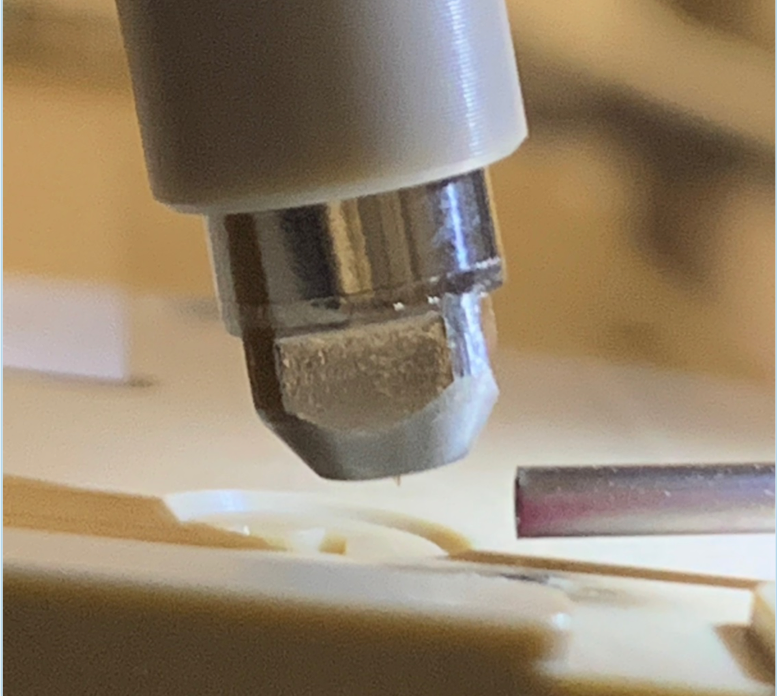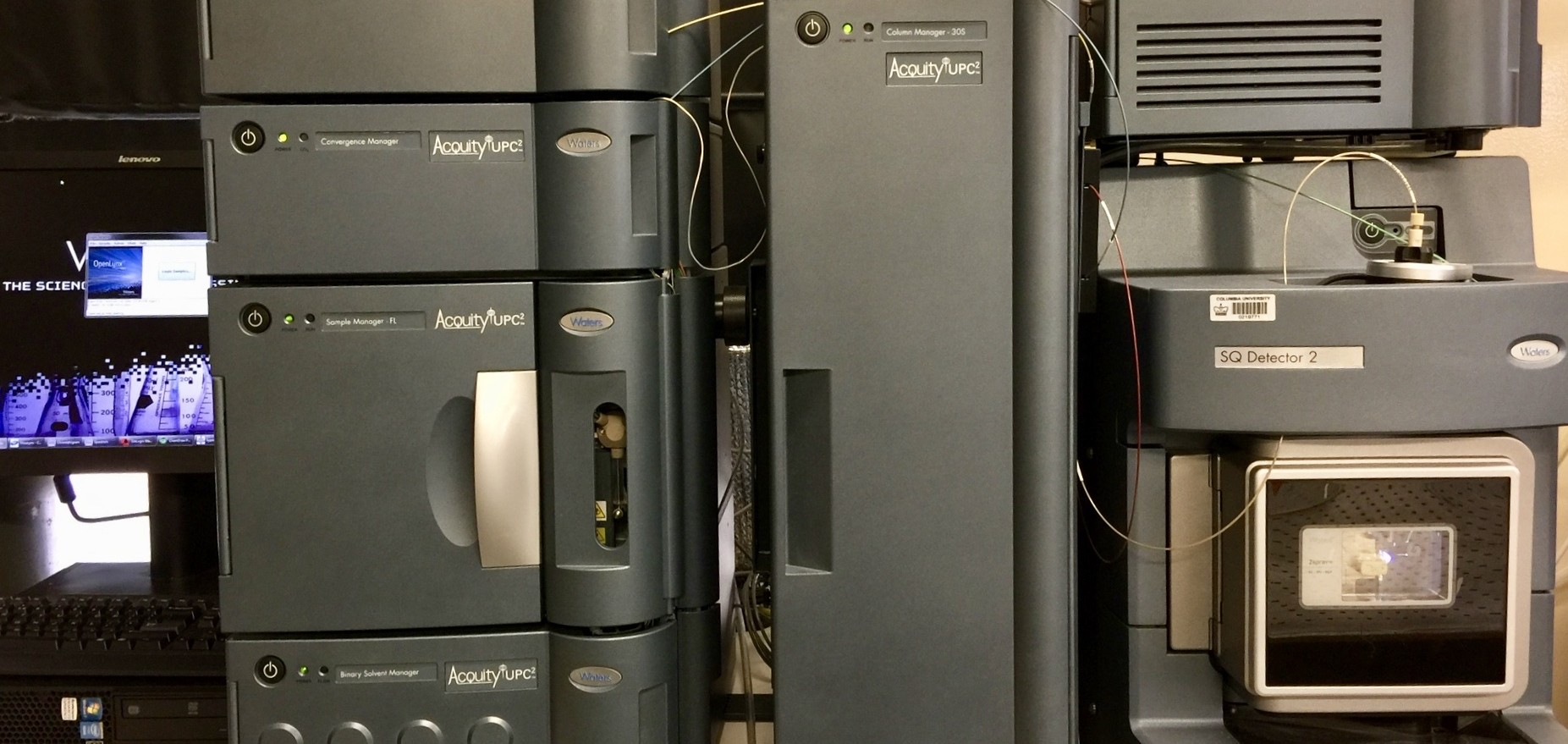APCI = Atmospheric Pressure Chemical Ionization | ASAP = Atmospheric pressure Solids Analysis Probe | DESI = Desorption ElectroSpray Ionization | EI = Electron Impact ionization | ESI = Electrospray Ionization | FIA = Flow Injection Analysis | MALDI = Matrix-Assisted Laser Desorption/Ionization | SFC = Supercritical Fluid Chromatography | TLC = Thin-Layer Chromatography | TOF = Time Of Flight | UPLC = Ultra Performance Liquid Chromatography
-
Applications
This instrument is available for self-service for trained users or by sample submission to be run by facility staff. Accurate mass analyses (HRMS) for small molecules are performed on this instrument. It is also used for quantitation and other experiments designed in collaboration with facility staff.
Description
The QTOF is attached to a Waters H-Class Plus UPLC for reversed phase and HILIC separations. A Waters UPC2 supercritical fluid chromatography system can also be attached for separation of low-to-medium polarity compounds. Both inlets include a photodiode array detector (PDA) for monitoring UV-vis absorption. The QTOF includes a resolving quadrupole, collision cell, and a TOF with a resolving power >40,000 FWHM. The ion source includes interchangeable ESI and APCI probes as well as an Atmospheric pressure Solids Analysis Probe (ASAP). The LockSpray reference mass provides improved mass accuracy and StepWave ion optics provide improved sensitivity. MS/MS, MSE, and TOF-MRM experiments are possible on this instrument. The LC and MS systems are run using MassLynx 4.2, which includes QuanLynx for processing quantitation data and MaxEnt for intact protein spectra deconvolution. Located in 216 Havemeyer. Installed February 2015.
Citation for publication
Accurate mass measurements/high resolution mass spectra (HRMS) were obtained from the Columbia University Chemistry Department MassSpectrometry Facility on a Waters XEVO G2-XS QToF mass spectrometer equipped with a UPC2 SFC inlet and a LockSpray source with one of three probes: electrospray ionization (ESI) probe, atmospheric pressure chemical ionization (APCI) probe, or atmospheric pressure solids analysis probe (ASAP).

Applications
This instrument is available for trained users in collaboration with facility staff. DESI-imaging is the primary application of this instrument (see MS Imaging page for more details – coming soon). By switching to an ESI source and attaching the I-Class Plus UPLC, this instrument becomes a step up from the Xevo G2-XS owing to its capacity for higher resolution chromatography, higher resolution mass spectra, and ion mobility spectrometry.
Description
The QTOF can be fitted with either a DESI source for MS imaging or ESI source for LC-MS experiments. With the ESI source, it is attached to a Waters I-Class Plus UPLC for reversed phase and HILIC separations. The QTOF includes a resolving quadrupole, an ion mobility drift cell, two collision cells, and a TOF with a resolving power >40,000 FWHM. The LockSpray reference mass provides improved mass accuracy and StepWave ion optics provide improved sensitivity. MS/MS, MSE, and TOF-MRM experiments and the corresponding HDMS (with ion mobility) experiments are possible on this instrument. The LC and MS systems are run using MassLynx 4.2, which includes QuanLynx for processing quantitation data. Progenesis QI and EZ Info are also available for more advanced analysis. Located in 216 Havemeyer. Installed February 2019.
Applications
This self-service instrument is available to all trained users by online reservation. MALDI is routinely used for obtaining mass spectra of singly charged large molecules such as proteins, RNA and DNA oligomers, and synthetic polymers (up to ~200 kDa). Isotopic resolution of smaller molecules (up to ~7 kDa) is possible, providing an alternative to the QTOF for high resolution mass spectra. Identification of pure, digested proteins is possible by peptide mass fingerprinting (PMF) as well as MS/MS sequencing of the peptide products. This instrument is now available for MS imaging as well (see MS Imaging page for more details – coming soon).
Description
The MALDI-TOF/TOF uses Bruker's Smartbeam-II technology (a frequency tripled Nd:YAG, 355 nm laser) for an adjustable laser profile with a 2 kHz firing rate. Both linear (low resolution, high m/z range) and reflector (high resolution, low m/z range) are available with a resolving power up to 40,000 FWHM. Bruker's LIFT technology is used for MS/MS analysis of fragments formed by post-source decay. A steel target plate, common matrices and calibrants, and sample prep equipment are available to users. A slide adapter is also available for MALDI imaging. PolyTools and flexImaging software are available for polymer analysis and MS imaging experiments, respectively. Located in 216 Havemeyer. Installed December 2016. A user guide for basic use of this instrument is available on the documents page.
Citation for publication
MALDI-TOF spectra were obtained from the Columbia University Chemistry Department Mass Spectrometry Facility on a Bruker ultrafleXtreme MALDI TOF/TOF. [Insert your recipe here].
Sample recipe: Dithranol matrix was dissolved in chloroform (10 mg/mL). Analytes were also dissolved in chloroform (2 mg/mL). Matrix and analyte solutions were mixed 1:1, then spotted (0.5 uL) onto a ground stainless steel plate and allowed to dry for 1 minute.
Applications
This walk-up instrument is available to all trained users by online reservation. The primary role of this multi-functional system is to help synthetic chemists monitor reactions. Users may directly inject diluted and filtered reaction mixtures, obtain mass spectra directly from TLC spots, or directly analyze solid materials and surfaces.
Description
The Advion ExpressIon CMS-L is a low resolution, compact, single-quadrupole mass spectrometer with a range up to 2000 m/z. ESI and APCI ion sources may be manually changed by users. Available inlets include Flow-Injection Analysis (FIA), PlateExpress TLC plate reader, and an Atmospheric pressure Solids Analysis Probe (ASAP). Located in 544 Havemeyer. Installed December 2015. A user guide for this instrument is available on the documents page.

Applications
This walk-up instrument is available to all trained users. The primary role of this system is to help synthetic chemists monitor reactions by supercritical fluid chromatography (SFC) with UV-vis and MS detectors. Three chiral phase columns also allow for rapid SFC separation or enantiomers for determination of enantiomeric excess. Quantitation studies are possible; however, the QTOF is recommended for these experiments.
Description
This Waters SFC-MS instrument includes a low resolution single-quadrupole mass spectrometer with a range up to 3000 m/z. A combined ESI and APCI source allows for rapid, automated switching between the two ionization types (positive and negative ions for each) all within a single run. Combined with a diode array detector (200 - 800 nm), the result is 5 chromatograms -- UV-visible, ESI+, ESI-, APCI+, and APCI-.
The UPC2 SFC system uses supercritical CO2 as the primary eluent with four solvents available as co-eluents. Temperature and back pressure are tunable within each method. Flow rates up to 3 mL/min and system pressures up to 6000 psi are possible. An 8-column changer allows for automated switching between columns, and the available column chemistries are given below. A photodiode array (PDA) detector allows for monitoring UV-vis absorption. Located in 544 Havemeyer. Installed February 2015. A user guide for this instrument is available on the documents page.
* Additional column chemistries available including Torus DEA, Trefoil CEL2, and Viridis BEH 2-EP.
NA